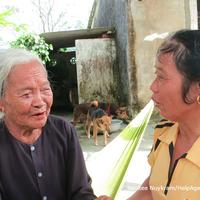In July this year I returned from a month-long trip to SE Asia where I was helping to coordinate a research project funded by Age International, WHO and the European Commission. The aim of the project is to look at the work of Older People’s Associations (OPAs) in 4 countries in the region, Cambodia, China, Vietnam and Myanmar. All the OPAs from which we are collecting data have been established with the support, either direct or indirect, of HelpAge International.
The OPAs are participatory membership organizations that are led or managed by older people, which means that their survival depends on the ability and willingness of the membership to contribute both time and resources to the organization. They provide older people with an opportunity to cooperate with age peers in the community, and if this cooperation is effective in meeting at least some local needs, they have a good chance of surviving beyond an initial period of project support (1-3 years). After this they are expected to be financially self-supporting, and the key to their financial sustainability lies with the management of funds which are used either to support cooperative enterprises (i.e. income-generating ventures) or to make loans to individuals (microfinance).
Donor funds are, therefore, essential for the establishment of the OPAs, not just for the intensive training that members receive in various management functions, but also for seed money that is used to start the various income generation schemes. The seed money is only a few thousand US dollars, but if it’s well managed it can grow, and when it grows the OPA can expand its activities. Because these are community development projects, sustainability has to be a crucial measure of success. The OPAs set out to give their members the means to do various things for themselves – the older people in the community – as well as for the wider community, and it is hoped that the organizations they establish will be able to flourish without the need for continual injections of large amounts of donor funds.
What do they do? As well as offering immediate and tangible benefits to all their membership, they aim to offer help and support (in various forms) to the most vulnerable older people in their community. They are multi-functional, and some of these functions reflect (i) the limited capacity of the state to provide help and support to older people, and (ii) the lack of income security of many of the members.
The countries included in the study share a common demographic context, even though the sheer extent and pace of change in China make it something of an outlier. Life expectancy for older people has been steadily improving over the last 30 years or so. Since all these countries have experienced considerable population growth over the same period, the improvements in adult survival mean that the absolute size of the older population has doubled (Myanmar and Vietnam) or more than doubled (Cambodia and China). With the single exception of Cambodia, the older population has been growing faster than the overall population. In all four countries, fertility has declined, though it is still above replacement level in Myanmar and Cambodia. The upshot of these changes has been a big increase in the population share of people aged 60+; and in China it as more than doubled.
The countries of East and South East are urbanising very quickly, and their changes in fertility and survival have been accompanied by high levels of out-migration of younger adults from the mostly rural communities in which the OPAs operate. The phenomenon is now making itself apparent even in Myanmar, which has been something if a laggard in this respect. Overall, it seems likely that out-migration is having a bigger impact on the age structure of villages than fertility decline.
Alongside the similarities in demography, there are evident similarities in the public provision of entitlements and services for older people. Even in China, which has introduced major reforms in the last decade and also has a relatively sophisticated health care service (for all its shortcomings), the capacity of the government to deliver pensions and health services for older people in rural areas is limited. Only China, moreover, is beginning to think seriously about government provision of long-term care, and heavy reliance on out-of-pocket payments for health care is the norm.
Despite their differences then – and they are many and considerable – the countries share enough to shape the objectives which the OPAs pursue in all these countries. They are all subject to common patterns of rapid demographic change; in all of them, the capacity of government to provide for the welfare of its vulnerable populations is limited; and poverty remains widespread in rural areas.
What are we trying to do in the research? We will use the data we are collecting (i) to assess the impact of the OPA approach on key aspects of the well-being of older people – their health, their income security and their integration into their communities; (ii) to elucidate the conditions for the successful delivery of improvements by OPAs in these domains; and (iii) to assess the sustainability and replicability of the OPA approach.
About the Author:
Kenneth Howse is a Senior Research Fellow at the Oxford Institute of Population Ageing. He is also a key member of The Collen Programme on Fertility, Education and the Environment.
Opinions of the blogger is their own and not endorsed by the Institute
Comments Welcome: We welcome your comments on this or any of the Institute's blog posts. Please feel free to email comments to be posted on your behalf to administrator@ageing.ox.ac.uk or use the Disqus facility linked below.













